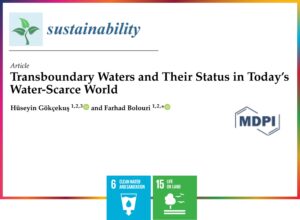
Gökçekuş, H., & Bolouri, F. (2023). Transboundary Waters and Their Status in Today’s Water-Scarce World. Sustainability, 15(5), 4234.
Researchers from Near East University's Energy, Environment, and Water Research Center have conducted a comprehensive study focusing on the complexities and challenges surrounding transboundary waters, crucial for sustaining life and livelihoods worldwide. With nearly 40% of the global population residing in regions connected by shared river and lake basins, the study highlights the vital significance of these water resources, which account for approximately 60% of the world's freshwater flow.
The research delves into an extensive analysis of transboundary water issues through a library-based study, utilizing authoritative sources such as reports from the United Nations and various reputable organizations. Addressing the escalating disputes over shared water resources in a world experiencing a decline in water availability, the study investigates diplomatic approaches, the concept of hydro-hegemony, associated risks, the water–energy–food nexus, and the 5Ps (People, Prosperity, Planet, Peace, Partnerships) of sustainable development.
Furthermore, the study provides insights into the significance of international cooperation concerning transboundary waters, distinguishing between positive cooperation driven by mutual intentions and negative cooperation involving diplomatic pressures and power struggles. Emphasizing the importance of collaborative efforts based on mutual benefits, the study advocates for peaceful resolutions to transboundary water conflicts.
The research accentuates that effective cooperation among nations is pivotal, especially in addressing the complexities of transboundary water management. By aligning with SDGs and emphasizing collaborative approaches, the study offers pathways towards achieving sustainable solutions, essential for promoting global water security, peace, and sustainable development.
For further details, access the original paper from the publisher's link:
https://www.mdpi.com/2071-1050/15/5/4234